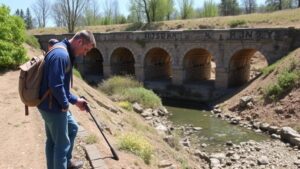Recovering Pottery Decorations From Eroded Riverbank Layers
Recovering Pottery Decorations From Eroded Riverbank Layers
The recovery of pottery decorations from eroded riverbank layers is a fascinating intersection of archaeology, geology, and conservation science. This process not only aids in understanding past human activities but also provides insights into the cultural heritage reflected in artistic practices. This article explores the methodologies, case studies, and implications of such recoveries, providing a comprehensive overview for scholars and enthusiasts alike.
The Importance of Pottery in Archaeology
Pottery serves as a critical resource for archaeologists due to its ability to provide chronological dating, insights into trade and daily activities, and cultural expressions through decorative styles. study of pottery allows researchers to reconstruct historical lifestyles and social interactions. For example, the presence of specific decorative techniques, such as slipware or incising, can indicate particular cultural traditions and periods.
Understanding Erosion and Riverbank Layers
Erosion is a natural process influenced by various factors, including water flow, vegetation, and human activity. Riverbanks are particularly vulnerable to erosion, which can uncover buried artifacts, such as pottery. As layers of soil displace and shift, they reveal stratified deposits that historians and archaeologists can analyze. Each layer can signify different time periods, offering a chronological sequence of human habitation and activity.
Methods of Recovery
Recovering pottery from eroded layers often involves a combination of physical excavation and scientific analysis. The following strategies are commonly employed:
- Stratigraphic Excavation: Excavators carefully dig through the layers of soil to maintain the context of each artifact. This method allows researchers to understand the chronological order of pottery decorations.
- Wet Sieving: This technique involves washing sediment through mesh screens. Tiny fragments of pottery become more visible, allowing for the recovery of delicate decorations that may be lost through dry excavation.
- Remote Sensing: Techniques such as ground-penetrating radar (GPR) and aerial photography help identify areas with potential artifacts without extensive disturbance to the site.
Case Studies of Successful Recoveries
Notable projects demonstrate the successful recovery of pottery from riverbank erosion. For example, the Thames River in London has been a rich site for archaeological discoveries. During a recent excavation, researchers recovered fragments of pottery dating back to the Roman period, adorned with intricate designs that provide context to the daily lives of its users.
Similarly, in the American Southwest, the archaeological site of Chaco Canyon yielded numerous pottery shards while utilizing stratigraphic excavation methods. These shards featured distinctive geometric patterns representative of the Ancestral Puebloans artistic expressions and revealed significant information about trade routes connected to Mesoamerican influences.
Challenges in Recovery
While the recovery of pottery decorations from eroded riverbank layers is an invaluable process, it is not without challenges. Erosion can lead to fragmentation and loss of context; thus, it is vital to employ thorough documentation during the recovery process. following challenges are commonly encountered:
- Fragmentation: Eroded pottery often arrives in numerous fragments, making reconstruction challenging. Advanced techniques like digital scanning can aid in visual restoration but require access to cutting-edge technology.
- Contextual Loss: When artifacts are rapidly exposed through erosion, their archaeological context may be lost, complicating the ability to derive meaningful conclusions regarding their use and significance.
The Future of Pottery Preservation
As riverbank erosion continues to threaten archaeological sites, innovative approaches to preservation and recovery become paramount. Collaboration between archaeologists, conservationists, and local governments can foster sustainable practices that protect significant sites. Preventive strategies may include:
- Useing Erosion Control Measures: Techniques such as planting vegetation along riverbanks can anchor soil to reduce erosion.
- Creating Awareness Programs: Engaging local communities in the importance of archaeological heritage can foster a sense of stewardship.
Actionable Takeaways
To wrap up, the recovery of pottery decorations from eroded riverbank layers is a critical endeavor for preserving cultural heritage. Emphasizing the importance of careful excavation methodologies, addressing challenges proactively, and implementing sustainable practices will enhance the fields findings and contribute to a more comprehensive understanding of our historical narratives. For those engaged in similar archaeological pursuits, prioritizing both scientific rigor and community involvement will yield invaluable results.


